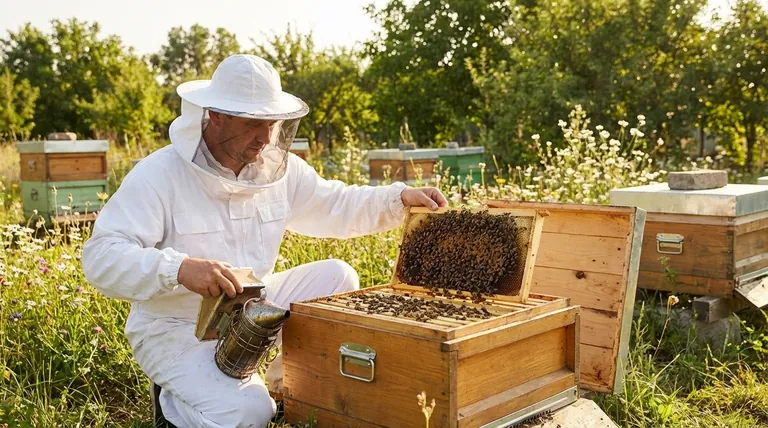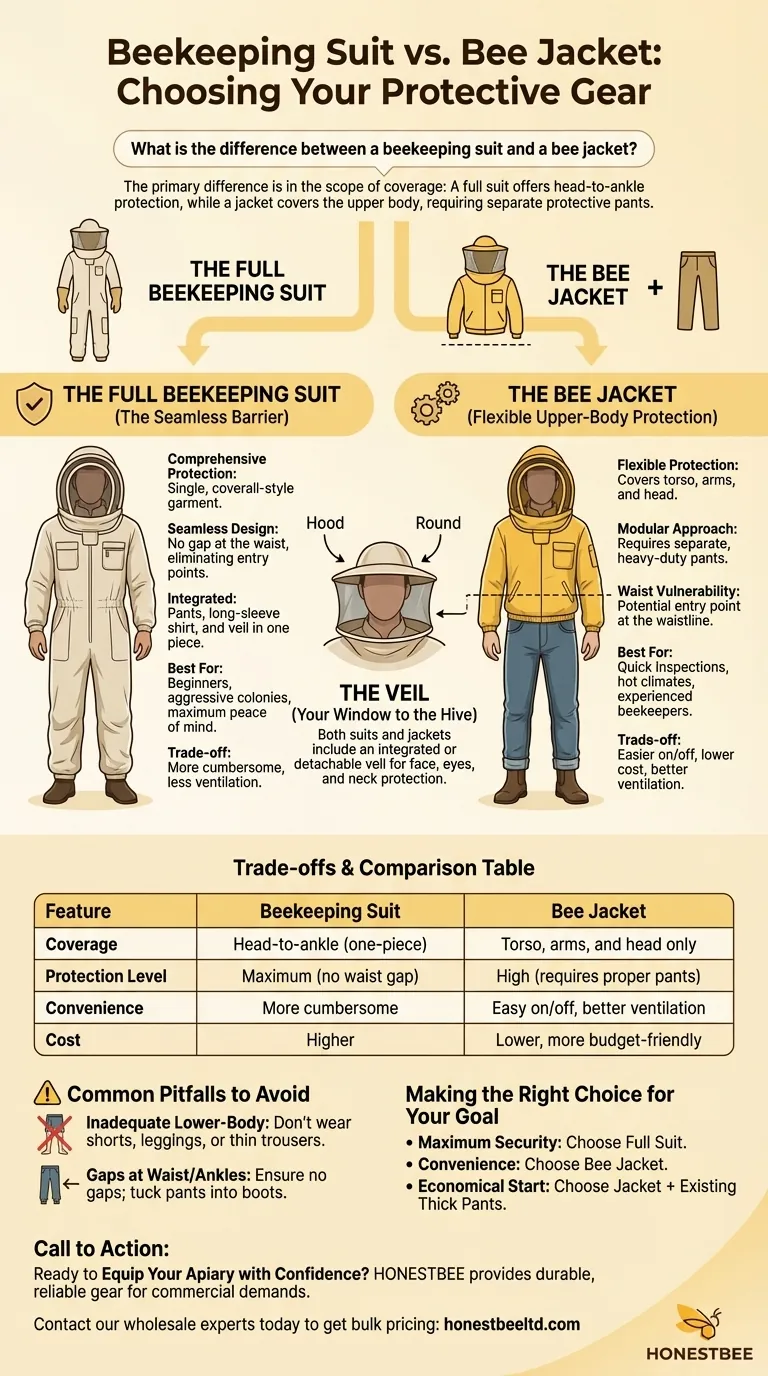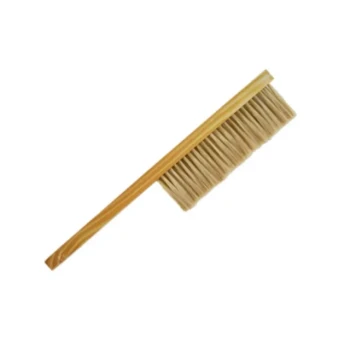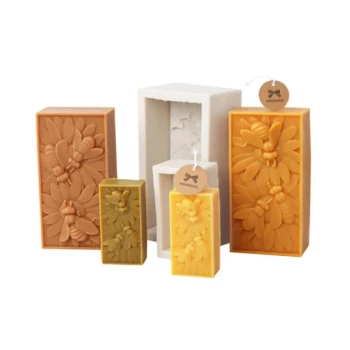The primary difference is in the scope of coverage. A full beekeeping suit is a single, one-piece garment offering head-to-ankle protection against stings. A bee jacket, by contrast, is an upper-body garment that includes the essential hood and veil but requires the beekeeper to provide their own protective pants.
The choice between a full suit and a jacket is not about which is universally "better," but about balancing the seamless security of a suit against the convenience and lower cost of a jacket. Your decision hinges on your personal comfort level around bees.

A Breakdown of Each Option
To make an informed choice, you must understand what each piece of equipment is designed to do and where its responsibilities end. Both are effective tools, but they solve slightly different problems.
The Full Beekeeping Suit: The Seamless Barrier
A full suit is the most comprehensive form of protection available. It is a single coverall-style garment that integrates pants, a long-sleeve shirt, and often the veil into one piece.
Its key advantage is the elimination of a gap at the waist. This seamless design provides the highest level of assurance that no bees can find an entry point while you are bending over or working the hive.
The Bee Jacket: Flexible Upper-Body Protection
A bee jacket provides identical protection to the top half of a full suit. It covers the entire torso, arms, and head, incorporating the same materials and veil designs.
The critical difference is that it ends at the waist. It must be paired with separate, heavy-duty pants to create a complete protective outfit. This modular approach offers greater flexibility but introduces a potential vulnerability at the waistline.
The Veil: Your Window to the Hive
Both suits and jackets come with an integrated or detachable veil. This mesh screen is the most critical component, as it protects your face, eyes, and neck.
Veil styles vary, from collapsible "hood" veils to more structured "round" veils with a built-in hat. This choice is largely a matter of personal preference regarding visibility and comfort.
Understanding the Trade-offs
Your decision should be based on a clear understanding of what you gain and what you give up with each option.
Protection Level: The Suit's Advantage
The full suit is objectively more protective due to its one-piece construction. For a beginner who is nervous or for anyone working with a particularly aggressive colony, this added peace of mind is invaluable.
Convenience: The Jacket's Clear Win
A jacket is significantly easier and faster to put on and take off, especially for quick hive inspections. It is less cumbersome to store and often more comfortable in hot weather, as it allows for more ventilation around the lower body.
Cost and Versatility: The Jacket's Edge
Bee jackets are typically less expensive than full suits. Furthermore, you can pair a jacket with sturdy work pants (like thick denim or canvas) that you may already own and can use for other tasks, making it a more versatile and economical choice.
Common Pitfalls to Avoid
The effectiveness of a bee jacket is entirely dependent on what you wear with it. This is the most common point of failure for new beekeepers.
Inadequate Lower-Body Protection
Never pair a bee jacket with shorts, leggings, or thin trousers. Bees can and will sting through light material. Always opt for thick denim jeans or heavy canvas painter's pants for reliable protection.
Creating Gaps at the Waist or Ankles
Ensure your pants are not low-rise, or wear a long shirt underneath the jacket to cover your back when you bend over. Crucially, always tuck your pants into your boots or socks. This simple step prevents bees from crawling up your leg, which is a common and unpleasant experience.
Making the Right Choice for Your Goal
Your final decision should align with your comfort level, beekeeping style, and budget.
- If your primary focus is maximum security and peace of mind: Choose the full beekeeping suit. Its seamless design removes any worry about gaps in coverage.
- If your primary focus is convenience for quick hive checks: The bee jacket offers excellent protection with far less hassle for frequent, short inspections.
- If your primary focus is the most economical start: A quality jacket paired with thick pants you already own is the most budget-friendly way to get started safely.
Ultimately, the best protective gear is the gear you will wear consistently and correctly, ensuring every interaction with your bees is a safe and confident one.
Summary Table:
| Feature | Beekeeping Suit | Bee Jacket |
|---|---|---|
| Coverage | Head-to-ankle (one-piece) | Torso, arms, and head only |
| Protection Level | Maximum (no waist gap) | High (requires proper pants) |
| Convenience | More cumbersome | Easy on/off, better ventilation |
| Cost | Higher | Lower, more budget-friendly |
| Best For | Beginners, aggressive colonies, maximum security | Quick inspections, experienced beekeepers, hot climates |
Ready to Equip Your Apiary with Confidence?
Whether you manage a few hives or a large commercial operation, having the right protective gear is non-negotiable for safety and productivity. At HONESTBEE, we supply durable, reliable beekeeping suits and jackets designed for the demands of commercial apiaries and distributors.
We help you protect your most valuable asset—your beekeepers—with high-quality equipment that ensures every hive inspection is safe and efficient.
Contact our wholesale experts today to discuss your needs and get bulk pricing: Get in Touch
Visual Guide

Related Products
- Cotton Beekeeping Suit and Round Hat with Veil Bee Keeper Protective Gear
- White Beekeeping Protective Suit and Hat with Fencing Veil for Beekeepers
- Heavy Duty Cowboy Beekeeper Hat with Visibility Veil Outdoor Professional Beekeeping Protective Gear
- Beekeeper Cowboy Hat and Veil for Beekeeping
- Professional Beekeeping Suit for Kids and Girls Childrens Bee Keeper Suit
People Also Ask
- Why is a jacket with a hat veil recommended for beekeepers? Essential Protection for Your Face and Neck
- What should be considered regarding the color of beekeeping clothing? Ensure Your Safety and Keep Bees Calm
- What factors should be considered when choosing a beekeeping suit? Balance Safety, Comfort & Performance
- What are bee suits made of? Choosing the Right Material for Maximum Protection & Comfort
- What is recommended for beginners in beekeeping regarding protective clothing? A Complete Safety Guide for New Beekeepers



















